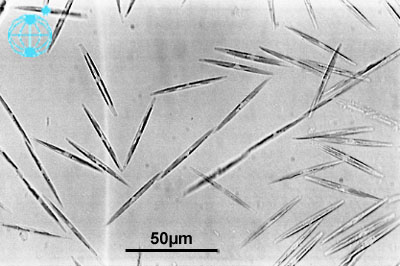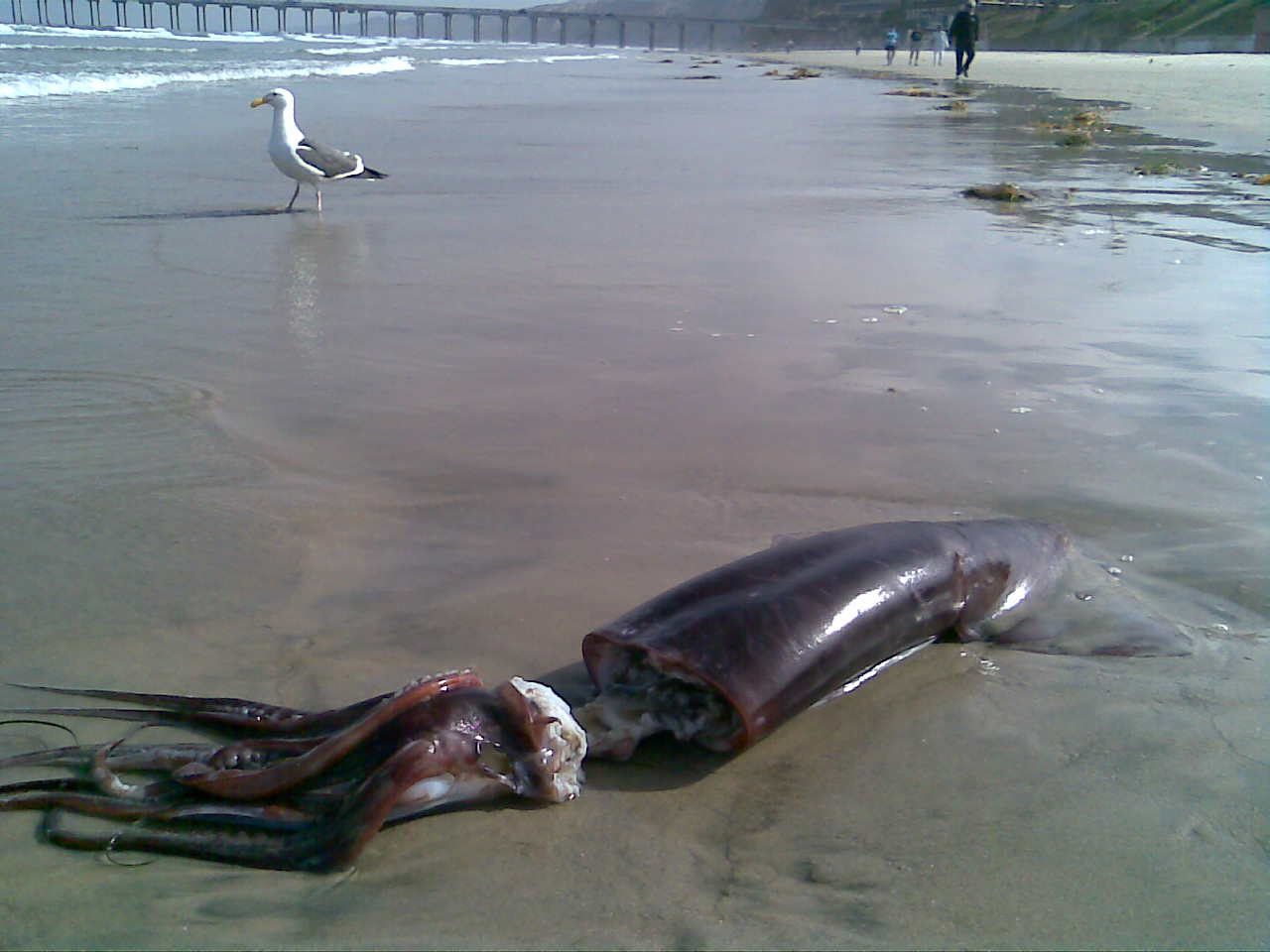So as it turns out, 2009 was the Time of finding neurotoxins in stranded Humboldt squid. I mean, obviously, right? Or, um, maybe not.
Let me explain: in 2009, a bunch of Humboldt squid stranded on beaches up and down the Pacific coast of North America. And two entirely independent groups of people had the same brilliant idea of taking samples from these stranded squid and looking for neurotoxins.
Why would you do this? The motivation comes from previous research on marine mammals. Although whale strandings are often just as mysterious as squid strandings, at least sometimes whales beach themselves due to brain damage from eating toxic food. What's bad for the whale might well be bad for the squid--but no one had ever looked before.
Group #1 consisted of me, who collected squid samples on La Jolla beach; Fernanda Mazzillo, who did all the chemical analysis; John Field, who checked out the stomachs to see what the squid had been eating; Melissa Carter, who looked at toxins in the ocean; and Mark Ohman, who gave us freezer space, mentorship, and motivation to get the whole project done.

Pseudo-nitzschia delicatissima by Gerhard Drebes
We learned that just before the stranding, there had been a population explosion of a type of single-celled marine algae, Pseudonitzschia delicatissima, which produces a toxin called domoic acid (DA). Like many other marine toxins, DA is concentrated by the food chain--animals that graze on the algae accumulate DA in their body tissues, and animals that eat those animals end up with even more DA, and so on.
Shellfish are particularly powerful DA collectors, since they filter huge quantities of algae out of the water. If humans eat these DA-loaded shellfish, they can get amnesic shellfish poisoning. But you can get DA poisoning from other animals besides shellfish. The stomachs of the stranded squid contained several fish species that could easily have been vectors for DA. And indeed, we found DA in both squid stomachs and body tissue--although the concentrations were fairly low.
So what's the answer? Did the La Jolla squid strand due to DA poisoning? Well, the low amounts of DA are within the ranges that have been measured from sea lions with definite symptoms of poisoning, so it's possible. But it's also worth noting that most of the fish they ate live in shallow water, and their stomachs also contained sand and algae. This peculiar gastronomic cocktail suggests that these squid, normally denizens of the open ocean, were foraging very close to shore. As we pointed out in our paper: "If this is an atypical habitat for them to exploit, they may have become disoriented and accidentally swam onshore."
Meanwhile, Group #2, consisting of Heather Elizabeth Braid, Jonathan Deeds, Stacey Lea DeGrasse, John James Wilson, Josephine Osborne, and Robert Harland Hanner, were studying a bunch of squid from the other end of the strandings, up on Vancouver Island. Like us, they checked the stomach contents and tested the body tissues for domoic acid, but they also looked for another thing: paralytic shellfish toxin (PST). Actually, there's a whole posse of PSTs, from saxotoxin to gonyautoxin. These folks tested for the lot.
They found low concentrations of DA, even lower than we did. But they found high concentrations of PST, and concluded that these toxins were a likely contributor to the strandings. The amounts of PST in the squid mantle tissue, the part that humans usually eat, were below "regulatory guidance levels for human consumption," which I think means you won't get paralytic shellfish poisoning from eating it. Similarly, the amounts of DA found by both groups were also well below guidance levels, so don't freak out about amnesia or paralysis if you've been eating Humboldt squid. However, some of the squid organs had really high levels of PST, like humans-definitely-should-not-eat levels, and unfortunately those organs are the parts that squid predators (like tuna, sharks, seals, and whales) really like to eat. Bad luck for them.
To recap: Squid in La Jolla may have stranded due to DA poisoning, or foraging too close to shore. Squid in Vancouver may have stranded due to PST poisoning. In any case, Humboldt squid can definitely accumulate toxins, which is a pretty serious thing when you consider how many animals (and people) love to eat them.

Stranded squid in La Jolla, photo by Mike Navarro. Head probably pecked apart by gulls like that nasty specimen in the background.
Now let me take a moment to explore the bizarre world of academic publishing. Remember, these strandings happened back in 2009. Both groups did their analyses in 2010, fully ignorant of each other's work, and submitted our papers to journals. Group #1 submitted to two different journals in 2010, both of which rejected the paper as outside their scope (targeting is hard!), then submitted to our final journal, CalCOFI Reports, at the beginning of 2011. CalCOFI Reports are published annually, at the end of the year, so our article didn't actually come out until the end of 2011.
Shortly after that, I saw the Braid et al. article in the first 2012 issue of Marine Biology. Like all good journals, Marine Biology is quite open about their publication timeline. In this case, it reads like so: "Received: 30 September 2010 / Accepted: 24 August 2011 / Published online: 11 September 2011." Just like us, Group #2 submitted in 2010 and found acceptance a year later.*
It's not like there's a blinding urgency to this line of research. There's no feeling of "Oh if only I had known that a year ago." But, great kraken on a cracker! A WHOLE YEAR? Here are two groups, working on complementary research, with no idea that they could have been talking and sharing ideas.
This is why we in the life sciences (and all the rest of science) really need to get on board with arXiv or something like it. If we were posting pre-prints of our work, we would be connected. We each would have been able to cite the other group's article, and write more comprehensive dicussions. We could even have improved each other's work--Group #1 might have been inspired to look at PST, and Group #2 to look at plankton blooms in the water.
I hope in a few years we'll look back on this as the Time for opening science . . .
* Edit: Heather told me that they also submitted to another journal first, and were also told that their research was outside that journal's scope. Maybe there's something particularly hard to target about this kind of research.
Braid, H., Deeds, J., DeGrasse, S., Wilson, J., Osborne, J.,&Hanner, R. (2011). Preying on commercial fisheries and accumulating paralytic shellfish toxins: a dietary analysis of invasive Dosidicus gigas (Cephalopoda Ommastrephidae) stranded in Pacific Canada Marine Biology, 159 (1), 25-31 DOI: 10.1007/s00227-011-1786-4




Comments